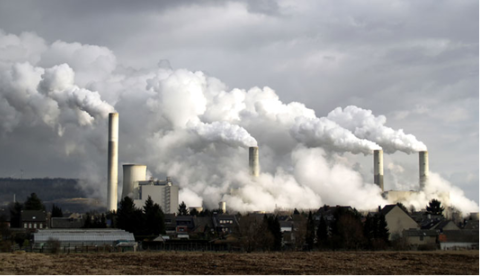Table of Contents
Air pollution is a pressing global environmental issue that poses significant risks to human health, ecosystems, and the planet as a whole. Air pollution refers to the presence of harmful substances in the Earth’s atmosphere, resulting from human activities and natural processes. These pollutants can be in the form of gases, particles, or biological agents. The major sources of air pollution include industrial emissions, vehicular exhaust, power generation, agricultural practices, and the burning of fossil fuels.

Types and Consequences of Air Pollution
- Particulate Matter (PM): Particulate matter consists of tiny particles suspended in the air. These particles can be solid or liquid and vary in size. PM can have detrimental effects on respiratory health, leading to respiratory illnesses, allergies, and decreased lung function.
- Ground-Level Ozone (O3): Ground-level ozone is formed when pollutants emitted by vehicles and industrial sources react with sunlight. High levels of ozone can cause respiratory problems, aggravate asthma, and lead to other respiratory ailments.
- Nitrogen Oxides (NOx) and Sulfur Oxides (SOx): These gases are primarily released from the burning of fossil fuels and industrial processes. They contribute to the formation of smog, acid rain, and respiratory issues. Additionally, they contribute to the formation of fine particulate matter.
- Volatile Organic Compounds (VOCs): VOCs are emitted from various sources, including paints, solvents, and industrial processes. Exposure to high levels of VOCs can cause eye, nose, and throat irritation, as well as long-term health effects.
Control Measures for Air Pollution
- The Air (Prevention and Control of Pollution) Act was passed in the year 1981, by the Indian Government. Noise pollution is also included in it later, in the year 1987.
- Emission Reduction: Implementing stricter emission standards and regulations for industries, vehicles, and power plants can significantly reduce air pollutant emissions. This includes adopting cleaner technologies, improving fuel quality, and promoting energy efficiency. Electrostatic precipitators remove particulate matter. Scrubbers remove SO2 from the thermal plant exhaust. Catalytic converters remove pollutants from automobile exhaust.
- Alternative Transportation: Encouraging the use of public transportation, cycling, and walking can help reduce vehicular emissions. The promotion of electric vehicles and the development of charging infrastructure can also contribute to cleaner transportation.
- Renewable Energy Sources: Shifting from fossil fuel-based power generation to renewable energy sources like solar, wind, and hydroelectric power can reduce emissions and air pollution associated with electricity production.
- Afforestation and Green Spaces: Planting trees and creating green spaces can help absorb pollutants, mitigate the heat island effect, and improve air quality. Trees act as natural filters, reducing particulate matter and providing oxygen. Many trees absorb sound as well and hence are planted like a fence in the industrial zones.
- Awareness and Education: Raising awareness about the causes and consequences of air pollution is crucial. Educating individuals, communities, and industries about sustainable practices, pollution prevention, and the importance of responsible behavior can foster long-term positive change.
Summary
Air pollution is a significant global environmental issue caused by human activities and natural processes. It consists of harmful substances such as particulate matter, ground-level ozone, nitrogen oxides, sulfur oxides, and volatile organic compounds. Air pollution has adverse effects on human health, ecosystems, and the planet. To control air pollution, measures such as implementing stricter emission standards, promoting alternative transportation, transitioning to renewable energy sources, planting trees and creating green spaces, and raising awareness through education are essential. These control measures aim to reduce pollutant emissions, mitigate health risks, and promote sustainable practices for a cleaner and healthier environment.
FAQs on Air Pollution Control
What is air pollution?
Air pollution refers to the presence of harmful substances in the Earth's atmosphere that can pose risks to human health, the environment, and the planet as a whole. These pollutants can be of natural origin or result from human activities such as industrial processes, transportation, and the burning of fossil fuels.
What are the main sources of air pollution?
The main sources of air pollution include industrial emissions, vehicle exhaust, power generation from fossil fuels, agricultural activities, and residential combustion of solid fuels. Natural sources, such as volcanic eruptions, dust storms, and wildfires, also contribute to air pollution.
What are the health impacts of air pollution?
Air pollution can have severe health effects, including respiratory problems, cardiovascular diseases, asthma, lung cancer, and premature death. Prolonged exposure to pollutants like fine particulate matter (PM2.5) and nitrogen dioxide (NO2) can lead to both short-term and long-term health issues, particularly for vulnerable populations such as children, the elderly, and those with pre-existing health conditions.
How does air pollution affect the environment?
Air pollution can harm ecosystems, vegetation, and wildlife. Acid rain, a consequence of air pollution, can damage forests, lakes, and rivers. Pollutants like nitrogen oxides (NOx) and sulfur dioxide (SO2) can contribute to the formation of smog and haze, impacting visibility and altering climate patterns. Air pollution can also disrupt the balance of ecosystems by harming plant and animal species.
What is the role of technology in air pollution control?
Technology plays a significant role in air pollution control. Innovations like emission control systems in vehicles, smokestack filters in industries, and cleaner energy generation technologies help reduce pollutant emissions. Advancements in monitoring systems, air quality modeling, and data analysis also contribute to better understanding and management of air pollution.
How can individuals contribute to air pollution control?
Individuals can contribute to air pollution control in various ways: Minimizing personal vehicle use and opting for public transportation, carpooling, or walking/cycling when feasible. Using energy-efficient appliances and reducing energy consumption at home. Properly maintaining vehicles to ensure efficient fuel combustion and reduced emissions. Avoiding burning of waste materials or using clean-burning alternatives like gas stoves. Supporting sustainable practices such as recycling, composting, and responsible consumption. Planting trees and supporting green initiatives that improve air quality. Advocating for policies and practices that prioritize clean air and environmental protection. Addressing air pollution requires collective action from governments, industries, communities, and individuals to create a healthier and more sustainable future for all.






